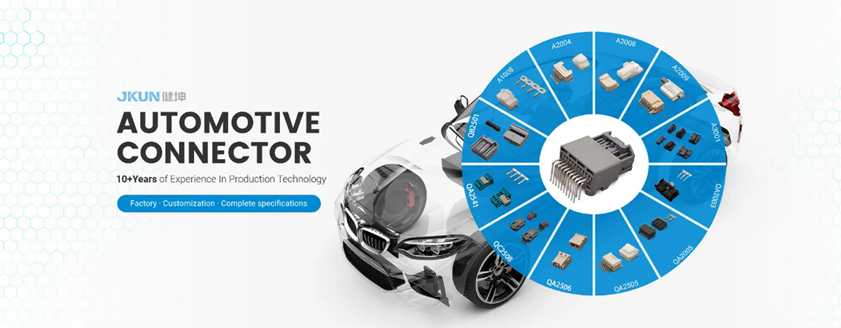
Behind the wave of tech companies crossing into automaking, connector technology is undergoing a strategic upgrade from "traditional components" to "intelligent cores".
On August 28, 2025, Dreame Technology, a leader in the smart cleaning industry, officially announced its entry into the automotive sector. It plans to build a global ultra-luxury new energy vehicle brand, with its first ultra-luxury pure electric product benchmarking against the Bugatti Veyron and expected to be unveiled in 2027.
This cross-industry move has not only attracted widespread attention from the industry but also revealed key pain points in the intelligent and electrified transformation of the automotive industry, as well as new opportunities in the supply chain. As the "neural hub" of automotive electronic systems, innovation and breakthroughs in connector technology are becoming the new focus of industrial competition.
01 Tech Companies Cross into Automaking, Supply Chain Reconstruction Imminent
Dreame Technology's entry into the automotive field is not impulsive. The company has accumulated profound expertise in core technology areas such as high-speed digital motors, AI algorithms, and robotic sensing and control. By May 2025, it had obtained 3,155 globally authorized patents and filed a total of 6,379 patent applications. These technologies provide strong support for its expansion into automotive electric drive systems, smart cockpits, and autonomous driving.
Dreame Automotive has built a team of nearly 1,000 people covering R&D, manufacturing, and quality control. The team includes both core R&D personnel from its original smart hardware business and senior experts from the traditional vehicle manufacturing sector, forming an organizational structure driven by the dual genes of "intelligence + manufacturing".
This cross-industry trend is reshaping the automotive supply chain system. The influx of tech companies has brought more agile development processes and faster technological iteration speeds, placing higher demands on core components like connectors: shorter delivery cycles, higher performance indicators, and stronger customization capabilities.
02 Automotive Connector Market Sees Both Volume and Price Growth
With the advancement of automotive intelligence and electrification, the connector industry is embracing unprecedented growth opportunities. The global automotive connector market size will reach USD 19.452 billion in 2025, and the Chinese market, accounting for 23%, has become the world's largest growth engine.
High-Voltage Connectors: Core Growth Driver for Electrification
New energy vehicles (NEVs) adopt electric drive systems, with operating voltages rising to 300-600V, significantly increasing the demand for the quantity and performance of high-voltage connectors. High-voltage connectors are mainly used in NEV batteries, PDU (Power Distribution Unit), OBC (On-Board Charger), DC/DC converters, air conditioners, PTC heaters, and AC/DC charging interfaces.
A single NEV requires 600-1,000 connectors, 2-3 times that of traditional fuel vehicles. Moreover, the value of high-voltage connectors per NEV is more than 3 times higher than that of fuel vehicles.
Connector Type | Application Scenarios | Value per Vehicle (RMB) | Technical Requirements |
High-Voltage Connectors | Three-Electric System, Charging System | 3,000 - 10,000 | High voltage resistance, high current, high reliability |
High-Speed Connectors | ADAS, Smart Cockpit | 500 - 1,000 | High speed, low latency, anti-interference |
Traditional Low-Voltage Connectors | Body Control, Basic Functions | 1,000 - 2,000 | Standardization, high reliability |
High-Speed Connectors: Core Carrier for Intelligence
With the advent of the connected car era and the popularization of autonomous driving, there is a need to collect and process more data at a faster speed. L2+ level autonomous driving models require the deployment of more than 20 sensors, and the usage of high-speed connectors per vehicle has surged by over 50% compared to traditional models.
High-speed connectors include FAKRA RF connectors, Mini-FAKRA connectors, HSD connectors, and Ethernet connectors. They are mainly used in cameras, sensors, broadcast antennas, GPS, Bluetooth, WiFi, keyless entry, infotainment systems, and navigation and driving assistance systems.

03 Technological Evolution: Four Innovation Directions Determine Competitiveness
The connector industry is in a period of technological fission, and four innovation directions are reshaping the industry landscape:
High-Frequency and High-Speed
With the widespread application of 5G millimeter-wave technology and the rapid development of satellite communications, the demand for RF connectors above 26.5GHz has shown explosive growth. Such high-frequency and high-speed connectors can achieve faster and more stable data transmission, becoming a key factor driving the further upgrading of communication technology.
Miniaturization and High-Density
Represented by the Type-C interface, whose pitch has evolved to 0.4mm, this places extremely high demands on the miniaturization and high-density integration of connectors. At the same time, MEMS (Micro-Electro-Mechanical Systems) technology is gradually becoming a new competitive focus in this field, promising to enable more powerful functional integration of connectors in small sizes.
Material Revolution
Traditional plastic materials are gradually unable to meet the growing demands in terms of high-temperature resistance and signal transmission performance, leading to the emergence of LCP (Liquid Crystal Polymer) materials. LCP materials have excellent high-temperature resistance, capable of withstanding temperatures up to 250℃, and perform well in signal transmission, gradually becoming the standard material for high-end connectors.
Intelligent Integration
In emerging fields such as the Industrial Internet of Things (IIoT), smart connectors with sensors are gradually emerging. These connectors not only fulfill the traditional electrical connection function but also collect and transmit equipment operation status data in real time, providing strong support for the intelligent management and maintenance of equipment.
04 Window for Domestic Substitution Opens, Local Enterprises Embrace Opportunities
The Chinese automotive connector market has long been dominated by foreign manufacturers. The combined market share of the three giants—TE Connectivity, Yazaki, and Aptiv—reached 67% (2019 data). However, the wave of new energy and intelligence is changing this pattern.
Three Driving Factors for Domestic Substitution:
Technological Iteration Advantage: NEV products have a faster iteration speed, and domestic enterprises have faster response capabilities and stronger service capabilities.
Cost Control Capability: Local enterprises have a highly competitive cost structure.
Supply Chain Security Demand: The impact of the epidemic on the automotive industry chain has led to a gradual shift of production capacity to China amid demands for supply chain security.
Currently, the localization rate of high-voltage connectors is less than 30%, and that of high-speed connectors is only about 5%, leaving huge room for substitution. Enterprises represented by AVIC Jonhon and RKDE have performed well in the high-voltage connector field, while Dongguan Electrical Connection Technology has shown strong strength in the high-speed connector sector.

05 Insights from Dreame's Automaking Venture: How Connector Enterprises Seize Opportunities
Dreame Technology's strategic decision to enter the automotive field provides important insights for connector enterprises:
Deep Participation in Early R&D
Dreame's automaking project has built a team of nearly 1,000 people and carried out in-depth cooperation with upstream and downstream industrial chains. Connector enterprises should proactively participate in the early R&D of vehicle manufacturers, jointly define product specifications, and realize the role transformation from "suppliers" to "partners".
Strengthen Technology Migration Capabilities
Dreame has migrated technologies such as high-speed digital motors and AI algorithms, accumulated in the smart hardware field, to the automotive sector. Similarly, connector enterprises need to transfer technological accumulations from consumer electronics, communications, and other fields to automotive scenarios—for example, applying miniaturization and high-frequency/high-speed technologies to smart cockpits and ADAS systems.
Layout Global Production Capacity
Dreame's business covers more than 100 countries and regions worldwide, with over 6,000 offline stores. Connector enterprises need to keep up with the global expansion of vehicle manufacturers, lay out overseas production capacity in advance, and meet local supply demands.
06 Conclusion: The Way for Connector Enterprises to Break Through in the Smart Vehicle Era
Dreame Technology's cross-industry entry into automaking reflects the vigorous vitality and unlimited possibilities of the smart vehicle industry. As cars transform from "means of transportation" to "intelligent terminals", connectors are no longer simple mechanical components but core hubs that carry energy flow and data flow.
Facing this historic opportunity, connector enterprises need to:
Focus on Technological Innovation: Break through technical bottlenecks in high voltage, high speed, and high reliability to meet electrification and intelligence needs.
Reshape Customer Relationships: Transform from single product supply to overall solution provision, and deeply participate in customers' R&D processes.
Build Ecological Cooperation: Form strategic synergy with upstream and downstream enterprises to jointly promote the formulation of industry standards and technological iteration.
The next few years will be a golden period for the rise of China's automotive connector industry. Only enterprises that grasp technological trends, keep up with customer needs, and continuously achieve innovative breakthroughs can seize opportunities in this once-in-a-century automotive revolution.
As the "neural hub" of automotive electronic systems, the progress of connector technology will directly determine the experience level of smart vehicles. Dreame's entry into automaking is just the beginning—greater industrial transformation is on the way.
Connector Product Recommendations:
| Product Category | Part Number | Altemative | Product Image |
Automotive Lighting connector | QC2508 | ||
| L25410AWB | |||
JST SZE-002T-P0.3/SZE-003T-P0.3 | |||
Automotive TPA/ISL Connector | QA20012 | ||
| QA2541 | |||
| QA2005 | |||
| QA2505 |
| Other Automotive Connector | QA2506 | TE 1-2381530-1-S-SOR-AO | |
| QA2007 | |||
| QA2203AWB | |||
| QCDT06 | |||
| QA1001 |